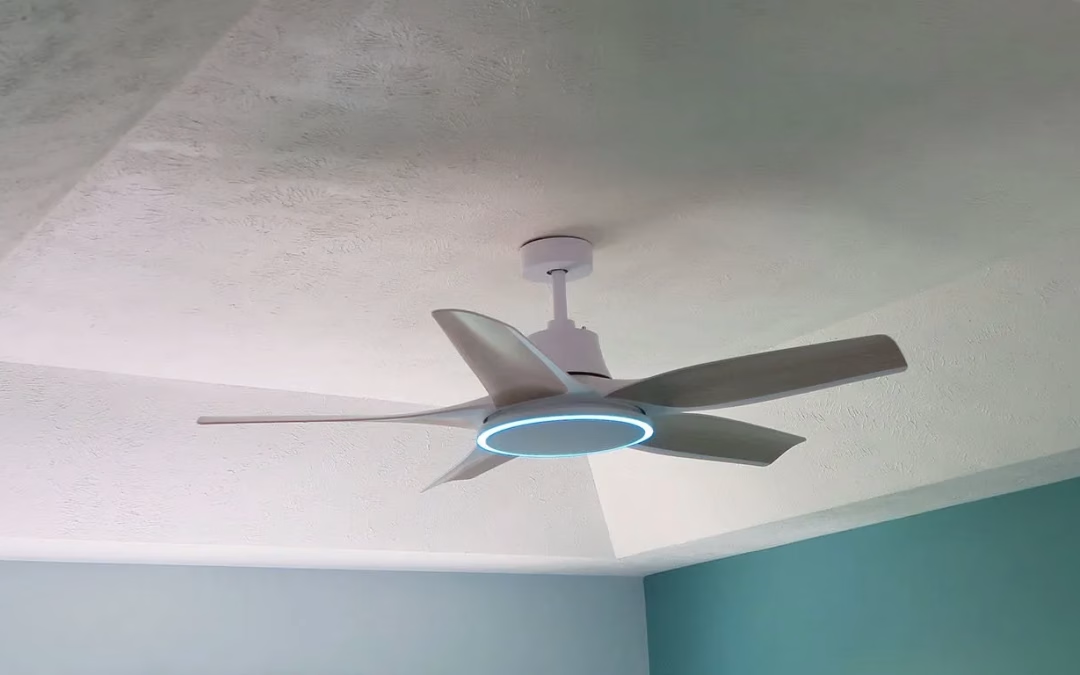If you’re in Florida, chances are you’ve got a ceiling fan spinning away already. But if yours is on its last legs or you’ve got a room that’s fan-less, it might be time to swap it out or add a fresh one!
With temperatures regularly hitting the 90s and humidity that makes the air feel like a wet blanket, air conditioning becomes a lifeline. But running your AC non-stop can send your electric bill through the roof. Enter the humble ceiling fan—a simple, cost-effective tool that can help you stay cool while keeping your energy costs in check.
According to the U.S. Energy Information Administration, cooling accounts for about 27% of a Florida household’s annual electricity use, with the bulk of that happening in summer. Ceiling fans can’t replace your air conditioner, but they can reduce how hard it has to work, saving you money without sacrificing comfort.
To get the most out of your ceiling fans in Florida’s summer, follow these practical tips:
- Set the Right Direction: Make sure your ceiling fan is spinning counterclockwise. This pushes cooler air downward, creating that refreshing breeze. Most fans have a switch to adjust the direction—check it at the start of summer.
- Choose Energy-Efficient Models: Look for Energy Star-certified ceiling fans, which use 15-20% less energy than standard models. Features like LED lighting and efficient motors can further reduce your electric draw. For example, an Energy Star fan running 12 hours a day costs about $10-$15 per year to operate, compared to $20 or more for older models.
- Use Fans Strategically: Install ceiling fans in high-traffic areas like living rooms, bedrooms, and kitchens. Don’t forget about patios and other outdoor areas you may have. Use them only when you’re in the room—fans cool people, not spaces, so running them in empty rooms wastes energy. Timers, remotes (app-enabled), and wall switches can help you remember to turn them off.
- Pair with a Higher Thermostat: Set your AC to 78°F or higher when you’re home, and let ceiling fans handle the rest. For every degree above 78°F, you could shave $5-$10 off your monthly bill, depending on your home’s size and AC efficiency.
- Maintain Your Fans: Dusty blades reduce airflow efficiency by up to 20%. Clean your fan blades monthly with a damp cloth, and ensure the motor is lubricated to keep it running smoothly.
Key Considerations for Choosing a Ceiling Fan
- Room Size and Blade Span:
- Mounting Type: Flush mount for low ceilings, downrod for high ceilings, or angled for sloped ceilings.
- Features: Look for reversible motors (counterclockwise for summer, clockwise for winter), multiple speed settings, remote or smart controls, and energy-efficient LED lighting.
- Noise Level: DC motors are quieter and more energy-efficient than AC motors.
- Style: Choose a design (modern, farmhouse, minimalist, etc.) that complements your decor.
- Energy Efficiency: ENERGY STAR® certified fans are up to 60% more efficient.
- Installation: Ensure a fan-rated electrical box and proper mounting to prevent wobbling.
Tips for Buying
- Check Airflow (CFM): Higher CFM (5,000+) is better for larger rooms. Consumer Reports emphasizes airflow and adjustability for performance.
- Noise: Opt for DC motors for near-silent operation, especially in bedrooms.
- Aesthetics: For a seamless look, match the fan color to your ceiling (e.g., white fan for white ceiling). Three-blade fans often look cleaner than five-blade ones.
- Durability: Brands like Hunter, Westinghouse, and Minka-Aire are frequently cited for longevity. Avoid cheap big-box store models, as some fail within months due to poor-quality components.
- Warranty: Look for lifetime motor warranties (e.g., Westinghouse, Hunter).
- Installation: Professional installation is recommended for safety, especially for heavier fans or complex wiring. Call us: 321-674-9667
Top Ceiling Fans for 2025
Here are some of the best ceiling fans based on testing and reviews from sources like The Spruce, Better Homes & Gardens, Consumer Reports, and Popular Mechanics, according to Grok.com:
- Best Overall: Honeywell Carmel 48-Inch Indoor Ceiling Fan
- Price: ~$136 (Amazon)
- Features: 5,202 CFM airflow, silent operation (even at high speed), remote control with wall mount, dimmable LED light, reversible motor, three blades, 48-inch span.
- Why It Stands Out: Easy to install, chic design, and highly efficient cooling for medium-sized rooms. Ideal for quiet environments like bedrooms.
- Best For: General indoor use, especially in living rooms or bedrooms.
- Best Budget: Hampton Bay Caprice Indoor Ceiling Fan
- Best for Small Rooms: Harbor Breeze Mazon 44-Inch Ceiling Fan
- Price: ~$107 (Amazon)
- Features: 44-inch span, low-profile flush mount, minimal noise, three blades, reversible blades, remote control, LED light.
- Why It Stands Out: Sleek, modern design with excellent airflow for small spaces like offices or bedrooms. Easy plug-connector installation.
- Best For: Small rooms or low ceilings.
- Best for Large Rooms: Honeywell Xerxes 62-Inch Ceiling Fan
- Best Smart Fan: Dreo Smart Ceiling Fan
- Best with Remote: Hunter Dempsey Ceiling Fan
- Best Outdoor: Hunter Indoor/Outdoor Ceiling Fan
- Best Design: Hampton Bay Chelia Gold LED Ceiling Fan
- Best Minimalist: Minka-Aire Light Wave 52-Inch Ceiling Fan
- Best Long-Lasting: Westinghouse Comet 52-Inch Indoor Ceiling Fan
- Price: ~$150–$200 (varies by retailer)
- Features: 52-inch span, five reversible blades, dimmable LED light, quiet operation, lifetime motor warranty.
- Why It Stands Out: Proven durability over years of use, affordable, and versatile for most rooms. Praised for being silent, powerful, and understated.
- Best For: Buyers seeking reliability and longevity.


